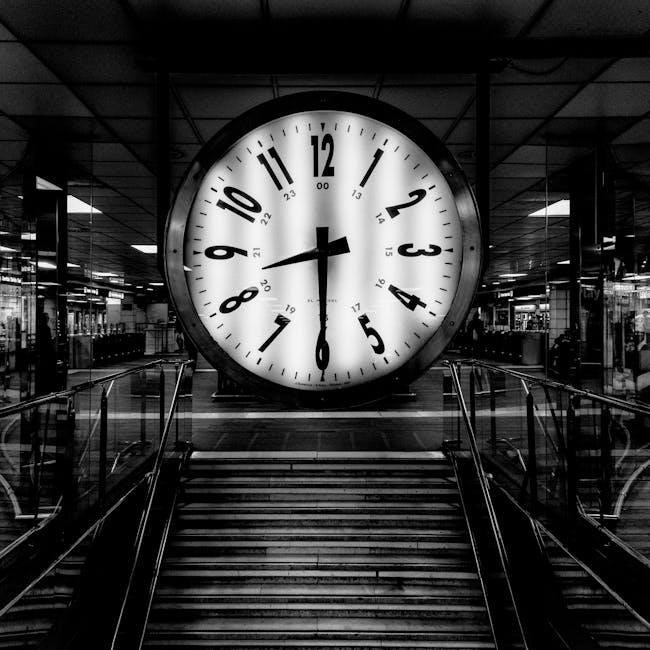William Butler Yeats’s poem‚ The Second Coming‚ written in 1919‚ captures the chaos and disillusionment of post-World War I Europe. It explores themes of cyclical history‚ chaos‚ and the collapse of order‚ symbolized by the widening gyre and the falcon’s disconnection from its falconer. The poem’s apocalyptic vision‚ featuring a “rough beast” emerging from the desert‚ subverts traditional Christian notions of redemption‚ offering instead a dark‚ unsettling prophecy. Its timeless relevance continues to resonate in modern discussions of societal upheaval and existential crisis.
1.1 Overview of the Poem and Its Historical Context
Written in 1919‚ The Second Coming reflects the post-World War I chaos and disillusionment in Europe. The poem captures the collapse of societal structures and the rise of anarchy‚ symbolized by the widening gyre and the falcon’s disconnection from its falconer. Drawing inspiration from global upheaval and Ireland’s political turmoil‚ Yeats crafts a haunting vision of history’s cyclical nature‚ blending mysticism with stark reality to depict a world on the brink of transformation.
1.2 Key Themes and Symbolism in the Poem
The Second Coming explores themes of chaos‚ anarchy‚ and the cyclical nature of history. The widening gyre symbolizes spiraling disorder‚ while the falcon’s disconnection from the falconer reflects societal collapse. The “rough beast” embodies a dark‚ apocalyptic force‚ subverting Christian notions of redemption. Yeats’s imagery‚ such as the “blood-dimmed tide” and “ceremony of innocence drowned‚” underscores the poem’s haunting vision of a world unraveling‚ replaced by a grotesque‚ inhuman power.
Historical Background and Inspiration
Written in 1919‚ The Second Coming reflects the turmoil of post-World War I Europe and Yeats’s fascination with mysticism. The poem captures the chaos and disillusionment of the era‚ inspired by the collapse of traditional structures and the rise of anarchy. Yeats’s interest in cyclical history and the occult shaped its apocalyptic vision‚ blending political and spiritual themes into a haunting prophecy.
2.1 The Influence of World War I on Yeats’s Work
World War I profoundly shaped Yeats’s worldview‚ as the conflict’s devastation mirrored the chaos in The Second Coming. The war’s aftermath‚ marked by political upheaval and societal collapse‚ influenced the poem’s apocalyptic themes; Yeats witnessed the disintegration of order and the rise of anarchy‚ themes reflected in the imagery of the falcon and the widening gyre. This historical turmoil deeply informed the poem’s vision of a world unraveling‚ aligning with his broader philosophical musings on cyclical history and humanity’s darker impulses.
2.2 Yeats’s Interest in Mysticism and the Occult
Yeats’s fascination with mysticism and the occult deeply influenced The Second Coming. His involvement with the Hermetic Order of the Golden Dawn and studies of spiritual systems shaped his vision of cyclical history and cosmic forces. The poem’s imagery‚ such as the gyre and the “rough beast‚” reflects his belief in mystical cycles of destruction and rebirth. This esoteric framework underscores the poem’s apocalyptic themes‚ blending spiritual and historical perspectives to create a haunting prophecy of chaos and transformation.

Poetic Structure and Style
Yeats employs a structured‚ lyrical form with rich imagery and metaphor‚ creating a haunting rhythm. The gyre and falcon symbols reflect his exploration of chaos and disorder‚ blending simplicity with profound depth to convey apocalyptic visions and existential dread‚ while maintaining a timeless poetic elegance that captivates readers universally.
3.1 The Use of Imagery and Metaphor
Yeats masterfully employs vivid imagery and metaphor to convey chaos and disorder. The “widening gyre” symbolizes spiraling disorder‚ while the falcon’s inability to hear the falconer mirrors societal collapse. The “blood-dimmed tide” and “ceremony of innocence drowned” evoke apocalyptic despair. The “rough beast” rising from the desert embodies primal‚ destructive forces. These metaphors create a haunting vision of a world unraveling‚ blending the surreal with the profound to explore themes of anarchy and existential crisis.

3.2 The Significance of the Gyre and the Falcon
The gyre‚ a spiraling‚ cyclical symbol‚ represents chaos and disorder‚ while the falcon’s disconnection from the falconer signifies a breakdown in control. The widening gyre reflects Yeats’s belief in historical cycles‚ where civilizations rise and fall. The falcon’s plight embodies the collapse of social structures‚ as disorder replaces harmony. Together‚ these images underscore the poem’s apocalyptic vision‚ where traditional order gives way to primal‚ destructive forces‚ mirroring humanity’s existential crisis.

Religious and Mythological Allusions
The Second Coming alludes to the Book of Revelation‚ invoking the Apocalypse of John. It subverts the Christian Second Coming‚ replacing the savior with a grotesque beast‚ symbolizing chaos over redemption‚ reflecting the collapse of spiritual and moral order.
4;1 The Concept of the Second Coming in Christianity
In Christianity‚ the Second Coming refers to the prophesied return of Jesus Christ‚ as described in the New Testament. It symbolizes divine redemption‚ judgment‚ and the establishment of a messianic kingdom. This event is central to Christian eschatology‚ embodying hope for believers and marking the ultimate triumph of good over evil. Yeats’s poem subverts this traditional notion‚ replacing it with a darker‚ apocalyptic vision that challenges conventional religious expectations.
4.2 Subversion of Traditional Christian Beliefs
Yeats’s poem subverts the traditional Christian concept of the Second Coming by replacing the anticipated messianic redemption with a dark‚ apocalyptic vision. Instead of Christ’s return‚ a “rough beast” emerges‚ symbolizing chaos and destruction. This twist challenges the hopeful narrative of salvation‚ offering a bleak‚ despairing outlook. The poem’s imagery‚ such as the “blood-dimmed tide” and “ceremony of innocence drowned‚” further underscores its departure from Christian ideals of peace and renewal.

The “Rough Beast” and Its Implications
The “rough beast” symbolizes chaos and destruction‚ emerging from societal collapse. It embodies the poem’s apocalyptic vision‚ representing the end of order and the rise of anarchy.
5.1 Interpretations of the Apocalyptic Vision
The “rough beast” symbolizes the collapse of civilization‚ embodying chaos and anarchy. Its emergence from the desert represents the end of order‚ reflecting post-WWI disillusionment. The vision subverts Christian hopes of redemption‚ replacing it with a dark‚ primal force. This apocalyptic imagery evokes fear and uncertainty‚ resonating with modern interpretations of societal collapse and existential crisis‚ making it a timeless commentary on humanity’s darker tendencies.
5.2 The Role of the “Rough Beast” in Modern Context
The “rough beast” symbolizes modern societal chaos and the rise of authoritarianism. Its apocalyptic imagery resonates with contemporary fears of democracy’s erosion and rationality’s decline. The poem’s vision of a world spiraling into anarchy aligns with current anxieties about global instability and misinformation. Yeats’s warning about the collapse of order remains eerily relevant‚ offering a timeless critique of humanity’s darker tendencies and the dangers of unchecked power.

Cultural and Literary Impact
The Second Coming is widely referenced in popular culture‚ media‚ and academic discussions‚ symbolizing societal chaos and existential crises; Its influence on poetry and thought remains profound.
6.1 References in Popular Culture and Media
The Second Coming is frequently referenced in popular culture‚ with its themes and imagery appearing in music‚ film‚ and television. For instance‚ the poem’s apocalyptic vision has inspired songs by prominent artists and been cited in TV shows like The Office. Its iconic lines‚ such as “things fall apart‚” are often used metaphorically in media to depict societal chaos and existential crises‚ underscoring its enduring relevance and universal appeal.

6.2 Influence on Contemporary Poetry and Thought
Yeats’s The Second Coming has profoundly influenced contemporary poetry and thought‚ inspiring modern poets to explore themes of chaos‚ order‚ and existential crises. Its imagery‚ such as the “widening gyre” and the “rough beast‚” has become symbolic of societal upheaval and political instability. The poem’s exploration of cyclical history and the collapse of meaning continues to resonate‚ shaping discussions on modernity‚ identity‚ and the search for meaning in an uncertain world.

Critical Analysis and Interpretations
Critical analyses of The Second Coming often focus on its exploration of chaos‚ order‚ and existential crises. Scholars interpret the poem’s imagery and themes as reflections of post-war disillusionment and the cyclical nature of history. Its psychological depth and philosophical undertones continue to inspire diverse interpretations‚ making it a cornerstone of modern literary critique and philosophical discourse.
7.1 Analysis of the Poem’s Political and Social Commentary
The Second Coming is a powerful commentary on the political and social upheaval of Yeats’s time. Written post-World War I‚ it reflects the chaos and disillusionment of a fractured world. The poem critiques the collapse of traditional order and the rise of authoritarianism‚ symbolized by the “rough beast” and the falcon’s disconnection from its falconer. It warns against the dangers of unchecked power and the erosion of moral and political stability‚ resonating with themes of societal decay and the cyclical nature of history.
7.2 Psychological and Philosophical Perspectives
The Second Coming delves into psychological and philosophical themes‚ exploring human anxiety and existential despair. The poem reflects a world spiraling into chaos‚ symbolized by the widening gyre and the falcon’s disconnection from its master. Yeats’s imagery evokes a sense of collective madness and the collapse of meaning‚ aligning with philosophical notions of existential crisis and the search for purpose in a fragmented world. The “rough beast” embodies primal forces beyond human control‚ questioning the nature of order and destiny.

Comparative Analysis with Other Works
The Second Coming shares thematic similarities with Shelley’s Ozymandias‚ both reflecting on impermanence and societal collapse. Yeats’s apocalyptic vision contrasts yet complements Shelley’s meditation on power’s transience.
8.1 Comparison with Shelley’s “Ozymandias”
Both The Second Coming and Ozymandias explore themes of decline and impermanence. Yeats’s apocalyptic vision mirrors Shelley’s reflection on power’s transience‚ as both poems critique societal collapse. The shattered statue in Ozymandias parallels Yeats’s “things fall apart‚” symbolizing the inevitable decay of order. While Shelley focuses on historical ruin‚ Yeats envisioning a “rough beast” offers a darker‚ more surreal prophecy‚ yet both works underscore the cyclical nature of history and humanity’s vulnerability.
8.2 Similarities and Differences with Other Apocalyptic Themes
Yeats’s The Second Coming shares apocalyptic imagery with works like the Book of Revelation‚ depicting societal collapse and divine judgment. However‚ it diverges by replacing hope with a dark‚ surreal vision of chaos. Unlike traditional apocalyptic themes promising redemption‚ Yeats’s poem introduces a malevolent “rough beast‚” symbolizing a world descending into anarchy without resolution. This subverts typical apocalyptic narratives‚ offering a grim‚ existential perspective on history’s cyclical decay.
The Second Coming remains a profound exploration of chaos‚ cyclical history‚ and humanity’s struggle with meaning. Yeats’s apocalyptic vision subverts traditional redemption narratives‚ offering a haunting‚ timeless commentary on societal collapse and existential uncertainty‚ ensuring its enduring relevance in literature and cultural discourse.
9.1 The Timeless Relevance of “The Second Coming”
The Second Coming remains remarkably relevant today‚ its exploration of chaos‚ cyclical history‚ and societal collapse resonating with contemporary anxieties. Written amid post-World War I turmoil‚ the poem’s apocalyptic vision captures the unraveling of order and the rise of uncertainty. Its haunting imagery‚ such as the widening gyre and the “rough beast‚” continues to evoke reflections on humanity’s recurring struggles with meaning‚ power‚ and existential crisis‚ ensuring its enduring resonance in modern discourse.
9.2 The Poem’s Enduring Legacy in Literature
The Second Coming is widely recognized as a seminal work in 20th-century poetry‚ its influence permeating literature‚ politics‚ and popular culture. Frequently referenced in media and public discourse‚ it has become a cultural touchstone for discussions of chaos and crisis. Its haunting imagery and philosophical depth continue to inspire poets‚ thinkers‚ and artists‚ ensuring its place as a cornerstone of modern literary thought and expression‚ transcending its historical context.

